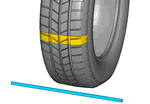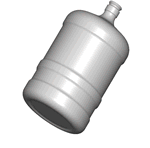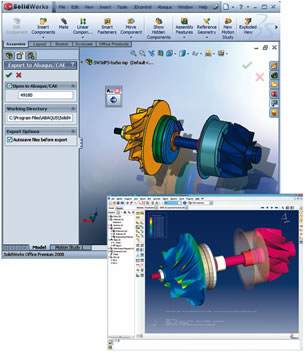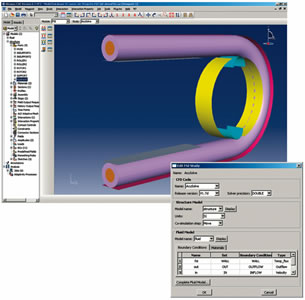Latest News
December 23, 2007
By DE Editors
 Coupled Eulerian-Lagrangian (CEL) analysis in Abaqus Explicit enables the modeling of complex fluid-structure interaction analysis, such as tire hydroplaning. |
Dassault Systemes (DS; Paris, France) announced Abaqus Version 6.7 Extended Functionality (EF), its finite element analysis (FEA) software suite from SIMULIA (Providence, RI) that is a unified finite element solution designed to increase confidence in design decisions, reduce physical testing, and accelerate time to market.
The release, which builds on SIMULIA’s open unified simulation environment, offers new capabilities that include native technology for multiphysics fluid-structure interaction (FSI), an associative geometry interface to SolidWorks, collaborative modeling capabilities, tools for managing material libraries, and visualization capabilities for solid composites.
Plus, the company says it also added dozens of customer-requested enhancements to the suite’s analysis solutions that simulate the real-world behavior of materials, processes, and products.
 Coupled Eulerian-Lagrangian (CEL) analysis allows drop-testing simulation of containers filled with fluids to study the durability and working life of the container under severe loading conditions directly in Abaqus. Model courtesy of Bayer MaterialScience, LLC. |
One new feature of Abaqus Version 6.7-EF is Coupled Eulerian Lagrangian (CEL) analysis, enabling fluid-structure interaction (FSI) within Abaqus/Explicit. CEL also provides the ability to analyze the performance of solid materials undergoing extreme deformation.
“The new multiphysics technology within Abaqus streamlines the process of evaluating the performance of structures interacting with fluids, such as tire hydroplaning or container drop, which is critical to improving product safety and quality,” said Steve Crowley, director of product management at SIMULIA.
Another new feature of Abaqus Version 6.7-EF is the Abaqus/CAE FSI Interface, which simplifies the process of defining coupled FSI models with third-party computational fluid dynamics software.
The SolidWorks Associative Interface provides geometry transfer, maintaining the relationship between SolidWorks and Abaqus models.
“The new multiphysics technology within Abaqus streamlines the process of evaluating the performance of structures interacting with fluids, such as tire hydroplaning or container drop, which is critical to improving product safety and quality.” — Steve Crowley, SIMULIA, |
Other features include collaborative modeling in Abaqus/CAE, which allows the import of models and objects from other Abaqus databases into the current analysis session, facilitating concurrent modeling between multiple engineers. Features created in Abaqus/CAE — such as loads, boundary conditions, sets, and surfaces — update automatically when the modified model is reimported from SolidWorks.
Parts and assemblies can be created in Abaqus/CAE using the constraint-driven sketcher, or they can be imported from CAD systems using neutral file formats. In addition, CAD associative interfaces for CATIA V5 and Pro/ENGINEER allow the synchronization of CAD and CAE assemblies and rapid model updates with no loss of user-defined analysis feaures. Abaqus/CAE’s meshing environment provides approaches for simplifying and speeding up mesh creation.
 The SolidWorks Associative Interface for Abaqus/CAE enables users to share components or an entire assembly from SolidWorks to Abaqus for advanced structural analysis. Modifications to the SolidWorks model can be quickly updated in Abaqus. |
The Material Library in Abaqus/CAE enables the efficient use and management of material properties from a variety of sources including proprietary corporate databases. Plus, new third-party plug-ins offered by Granta Designand Materealityprovide access to a range of materials associated with industrial and military/ aerospace databases.
Abaqus Version 6.7-EF includes contact enhancements for pre- and postprocessing that offer automatic contact detection support, geometry- and mesh-based searches, and contact output. There are also improvements to the Distributed Memory Parallel solver that support parallel element operations with steady-state transport, improved performance, and scalability for analyses with a large number of processors.
Abaqus/Standard provides a framework for high-performance, large-scale linear dynamics powered by the Abaqus/AMS eigensolver. More features include permanent set with hyperelasticity in Abaqus/Standard and Abaqus/Explicit that enables higher fidelity modeling of filled elastomers and thermoplastics such as those used in car door seals, mounts, and sports equipment.
Also, composites solid modeling enables the direct assignment of material layers to solid elements and provides results visualization of solid composites. Visual diagnostics enable the progress of analyses to be tracked and assessed easily. Very large, complex models can be visualized using a wide range of options including contour, path, x,y, and ply stack plots.
 In this example of a peristaltic pump, the Abaqus/CAE FSI Interface is used to simplify the process of defining fluid-structure interaction (FSI) models in Abaqus coupled with third-party computational fluid dynamics (CFD) software. |
According to DS SIMULIA, many applications involve the interaction of multiple physical phenomena. For example, to design safe and effective drug-eluding stents, engineers must account for the interplay between blood flow and stent deformation. Other challenging applications include coupled piezoelectric-acoustic effects in the design of hearing aids and coupled thermal-electrochemical interaction in fuel-cell design. Abaqus says it offers a growing range of native multiphysics capabilities including thermal-electrical, structural-acoustic, and pore fluid flow-mechanical interaction.
“This extended functionality release of Abaqus demonstrates our focus on advanced simulation technology and usability features that enable our customers to accelerate the evaluation of the real-world behavior of their products,” said Crowley.
Click here to go to DS SIMULIA’s site.
Click here for datasheets and technical resources on DS SIMULIA’s Abaqus FEA Product Suite.
Click here for DS SIMULIA’s coverage on Multiphysics.
Click here to link to a brochure detailing Abaqus Unified FEA, Version 6.7.
Click here to visit Dassault Systemes (DS).
Subscribe to our FREE magazine, FREE email newsletters or both!
Latest News
About the Author
DE’s editors contribute news and new product announcements to Digital Engineering.
Press releases may be sent to them via [email protected].






